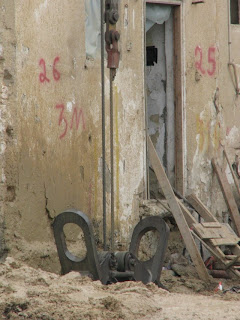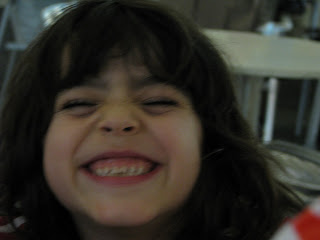A bit of the more modern history (as opposed to the ancient or Biblical history) of Joppa will set the stage:
There used to be a saying among German and Dutch sailors, when a task was particularly difficult, and there was small chance of survival or success. They would say that to carry out that task was "to go to Jaffa beach." This saying came from the fact that the water around the port of Jaffa is shallow and peppered with sandbars and rocks that it is difficult for ships to avoid. Pilgrims who arrived to the Holy Land via this port were often dismayed to find that their ship had to stop a great distance from shore, and that they then had to ride smaller boats, or even walk through the water, to get to the land. But yet it was an important port, and may well be one of the oldest in the world, used by both the Canaanites and the Philistines.
It was conquered by Napoleon on March 7, 1799, during his conquest of the Holy Land. He was so angered by the residents' resistance that when his soldiers finally broke into the city, he slaughtered its inhabitants. Many of his own soldiers then died of plague they contracted through proximity to all of the rotting corpses. Two years after that horrible event, visitors to Jaffa said they could still smell the stench of decaying bodies. Lovely place indeed!
But for a town that has seen so much violence, its modern incarnation is very pleasant and peaceful. It prides itself on being a home to contemporary artists, and expensive showrooms line most of the small streets. The restaurants along the water are popular hangouts for locals, and we had one of the best meals of our trip there.

LOOK, I'M A HISTORICAL SITE!
In fact, the first thing we did there was eat. We had breakfast at a well-known local establishment, the Aboulafia Bakery. I had a doughnut. A real doughnut, warm and rolled in granulated sugar. That may sound like a simple pleasure, but it was the first time in months I had had one, and eating it while sitting on a bench overlooking the sea was just wonderful.
Our first visit was to the Visitor's Center in Kedumim Square, where some ruins of Roman houses have been excavated and filled with amusing mannequins:

There was also an extremely entertaining film shown there.
Another other building of note in the square is the Monastery of St. Peter, built in 1891 over the ruins of a Crusader fortress:

Just off the square, up a small hill, is the Wishing Bridge. It is decorated with bronze images of the 12 signs of the zodiac, and if you stand clasping your sign and make a wish while looking out towards the sea, it is supposed to come true. I can verify that it does not work. Or maybe it didn't work for me because I could not reach far enough to touch both of my signs, Sagittarius and Capricorn, since I am one of those rare people born on a day that falls between two signs. We will have to go back to see if Peter's wish came true, because he wished that they would make a better-looking image of his zodiac sign (the ram) to put on the bridge.

Other sites in Jaffa include this interesting living statue:

A SUSPENDED ORANGE TREE IN THE ARTISTS' QUARTER.
Since the late 19th century, oranges have been the main export of Jaffa, and many of you have probably had some of the famous Jaffa oranges at some point.
Jaffa (Joppa) was also the port from which Jonah embarked when he tried to flee from God, and was eventually swallowed by the big fish (Jonah 1:3). A whimsical statue commemorates this event:

Joppa was also one of the places where the apostle Peter stayed for some time, at the house of a man named Simon the Tanner (Acts 9:43). The house is still there (sure), but it was locked when we went by.
For those more interested in ancient Greek and Roman mythology, the port of Joppa was famous as the site where Andromeda was chained up as an offering to a sea monster, and where Perseus swooped in with the head of Medusa and saved her. Here is the actual rock:

YES, THAT LITTLE ROCK OFF TO THE RIGHT OF THE PICTURE. WOW, RIGHT?
It's really not very impressive at all, especially when you consider how shallow the water is around it. Some seamonster!
It was a pleasant day, and just what we needed to unwind from the intense touring we had been doing for almost two weeks.
A JAFFA MYSTERY: WHAT IS THIS MACHINERY? ANYONE? DAN PERHAPS? FOY?


THIS IS IT IN A VERY DEEP HOLE
But we had one more task to complete before making it back to the Research Center that night. We were bringing Tsameret's two children back from Tel Aviv to Istanbul. I was slightly surprised that we were even allowed to leave the country with them, since they have Israeli passports and we do not.

SHEKED IN THE AIRPORT.

ILAN AND YUVAL.
Their father, Ilan, was able to come with us to the gate, but even so I would have thought security would have been tighter. But of course we are all glad it was not. The plane ride home was VERY bumpy -- much more than usual, even with some weather turbulence. The kids thought it was great fun, but Peter and I were quite nervous. Of course the littlest, Yuval, fell asleep only about 10 minutes before we landed, so for a few hours we were very busy entertaining two kids that we don't even share a language with! But it was fun, and we came out of it with a new respect for parents traveling with small children.
We finally made it back home, completely exhausted, but with much to contemplate. History, religion, politics -- the trip changed or augmented our understanding of many things. It was a very valuable experience indeed.

1 comment:
Not sure what it exactly that piece of machinery is called, but it is used in slurry wall construction. They used that technique extensively during "The Big Dig" in Boston. Basically it is a narrow clam shell bucket. They dig the hole, which is usually wet. They fill it with a dense slurry. This keeps the walls of the excavation from crumbling. Once they dig to the required depth they pump concrete into the hole (usually a long trench at this point), displace the slurry, then after the concrete cures excavate the dirt. It's very effective for tight quarters and used a lot for shallow tunnel work like for highways and subways. Not usually as structural walls, but as groundwater "shutoffs" or diverters.
Post a Comment